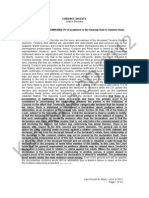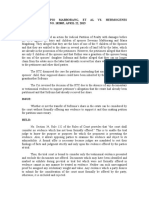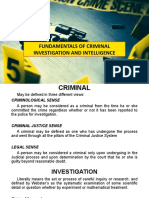People Vs Aleman GR No. 181539 Facts
People Vs Aleman GR No. 181539 Facts
Uploaded by
Jessette Amihope CASTORCopyright:
Available Formats
People Vs Aleman GR No. 181539 Facts
People Vs Aleman GR No. 181539 Facts
Uploaded by
Jessette Amihope CASTOROriginal Title
Copyright
Available Formats
Share this document
Did you find this document useful?
Is this content inappropriate?
Copyright:
Available Formats
People Vs Aleman GR No. 181539 Facts
People Vs Aleman GR No. 181539 Facts
Uploaded by
Jessette Amihope CASTORCopyright:
Available Formats
People vs Aleman
GR No. 181539
Facts:
Edwin Aleman was charged with the special complex crime crime of robbery
with homicide. The accused conspired and mutually helped with another unidentified
person, robbed and killed Mr. Ramon Jaime Birosel while the victim was inside his car
talking over his cellphone. The prosecution established the cause of death of the victim
shown in the medico-legal report. The case relied on sole-eyewitness’ account of Mark
Aldovar, a 14-yr old deaf mute. During trial, a licensed sign language interpreter
assisted him in his testimony. He communicated- the situation of the victim who had
just boarded his car; the respective positions of accused and his still unidentified cohort
vis-à-vis the victim; accused knock on the window of the victim’s car and the sudden
series of stabs accused inflicted upon the victim; the taking of the victim’s various
personal properties; accused walk away from the crime scene; and, the revelation of
accused identity when he finally removed the bonnet that covered his face. However,
accused interposed denial and alibi. He was twice made to join a police line-up and
thereafter was given a spot report as the alleged suspect and turned over to police
custody. He stated that witness failed to identify him during police line-up. RTC
rejected the defenses of the accused but viewed the prosecution's evidence favorably,
particularly the eyewitness testimony as simple and credible and his positive
identification. On appeal, accused aimed at discrediting the witness. He questioned the
qualification of Mark as witness being deafmute and failure to identify him as
perpetrator during the line-up. CA denied the appeal and affirmed with RTC that
prosecution was able to establish beyond reasonable doubt all the elements of robbery
with homicide.
Issues:
1. W/N Mark, a deaf-mute, can be a competent witness?
2. W/N the non-identification of accused in police line-up would prejudice the
case?
Held:
1. Yes. The mere fact that Mark is a deaf-mute does not render him unqualified to be a
witness. The rule is that “all persons who can perceive, and perceiving, can make
known their perception to others, may be witnesses.” In this case, he was able to
communicate through drawing and sketches in open court to show the relative position
of things and persons as he perceived like a normal person. Thus, a deaf-mute is
competent to be a witness so long as he has the faculty to make observations and he can
make those observations known to others. RTC and CA saw no improper motive, which
would impel Mark to testify falsely against the accused.
2. No. There is no law stating that a police line-up is essential to proper identification.
What matters is that the positive identification of the accused as the perpetrator of the
crime be made by the witness in open court. But the records show that Mark identified
accused-appellant as the robber-killer of the victim in a police line-up and, more
importantly, in open court in the course of Mark’s testimony. Moreover, the settled rule
is that the positive and credible testimony of a single witness is sufficient to secure the
conviction of an accused. The Supreme Court denied the appeal of accused-appellant.
You might also like
- People vs. Floresta - REMDocument17 pagesPeople vs. Floresta - REMmaiah1981No ratings yet
- 2 Case Digest - de Jesus v. Sanchez-MalitDocument2 pages2 Case Digest - de Jesus v. Sanchez-MalitJoyce AllenNo ratings yet
- G.R. No. 76873Document7 pagesG.R. No. 76873Gemma acostaNo ratings yet
- Lorelei Iladan Vs La Suerte International Manpower AgencyDocument1 pageLorelei Iladan Vs La Suerte International Manpower AgencyGretchenNo ratings yet
- RULE 130 (Testimonial Part 4)Document14 pagesRULE 130 (Testimonial Part 4)Joseph Rinoza PlazoNo ratings yet
- Villanueva vs. Balaguer, G.R. No. 180197, June 23, 2009Document2 pagesVillanueva vs. Balaguer, G.R. No. 180197, June 23, 2009Tootsie Guzma0% (1)
- People of The Philippines vs. Romy Lim y Miranda G.R. No. 231989. September 4, 2018Document3 pagesPeople of The Philippines vs. Romy Lim y Miranda G.R. No. 231989. September 4, 2018Leere BravoNo ratings yet
- PEOPLE OF THE PHILIPPINES v. DANILO JAPAG AND ALVIN LIPORADADocument1 pagePEOPLE OF THE PHILIPPINES v. DANILO JAPAG AND ALVIN LIPORADArafael.louise.roca2244No ratings yet
- People v. RacquelDocument1 pagePeople v. RacquelJennilyn TugelidaNo ratings yet
- Case Digest Feb 29 EvidenceDocument5 pagesCase Digest Feb 29 EvidenceLuriza SamaylaNo ratings yet
- G.R. No. 143439 - Alvarez v. RamirezDocument2 pagesG.R. No. 143439 - Alvarez v. Ramirezaileen reyesNo ratings yet
- Yap vs. Lagtapon Full TextDocument10 pagesYap vs. Lagtapon Full TextfreezoneNo ratings yet
- TAMARGO V AWINGANDocument2 pagesTAMARGO V AWINGANBananaNo ratings yet
- OBJECT EVIDENCE People Vs BardajeDocument2 pagesOBJECT EVIDENCE People Vs BardajeAdi LimNo ratings yet
- 06 People v. LagahitDocument2 pages06 People v. LagahitJet SiangNo ratings yet
- Seiler vs. Lucas Film (797 F.2d 1504 (1986)Document8 pagesSeiler vs. Lucas Film (797 F.2d 1504 (1986)Analyn Grace Yongco BasayNo ratings yet
- MA. ANTONETTE LOZANO, PETITIONER, v. JOCELYN K. FERNANDEZ RESPONDENTDocument7 pagesMA. ANTONETTE LOZANO, PETITIONER, v. JOCELYN K. FERNANDEZ RESPONDENTKimberly Sheen Quisado TabadaNo ratings yet
- Veranga Vs Republic (Chelle)Document1 pageVeranga Vs Republic (Chelle)Chelle VenturaNo ratings yet
- G.R. No. 239957 - Trinidad Vs PeopleDocument8 pagesG.R. No. 239957 - Trinidad Vs PeopleAlfred Robert BabasoroNo ratings yet
- Rule 130 CASE DIGEST 3. Testimonial E Vii. Res Gestae 2. People vs. MercadoDocument4 pagesRule 130 CASE DIGEST 3. Testimonial E Vii. Res Gestae 2. People vs. MercadoCheenee Nuestro SantiagoNo ratings yet
- MABBORANG V MABBORANGDocument2 pagesMABBORANG V MABBORANGMac100% (1)
- Heirs of Sabanpan Vs Comorposa 408 Scra 692Document2 pagesHeirs of Sabanpan Vs Comorposa 408 Scra 692Racheal SantosNo ratings yet
- Digest Country Bankers V LagmanDocument2 pagesDigest Country Bankers V LagmanAleph JirehNo ratings yet
- EVIDENCE - Case 5 - Yap Vs LagtaponDocument3 pagesEVIDENCE - Case 5 - Yap Vs LagtaponJas ParasNo ratings yet
- People vs. UmaliDocument2 pagesPeople vs. UmaliChezca MargretNo ratings yet
- BANCO FILIPINO SAVINGS AND MORTGAGE BANK vs. HON. FIDEL PURISIMA, Etc., and HON. VICENTE ERICTA and JOSE DEL FIERO, Etc.Document2 pagesBANCO FILIPINO SAVINGS AND MORTGAGE BANK vs. HON. FIDEL PURISIMA, Etc., and HON. VICENTE ERICTA and JOSE DEL FIERO, Etc.Dave Lumasag CanumhayNo ratings yet
- People vs. SerenasDocument2 pagesPeople vs. SerenasLara YuloNo ratings yet
- Scra Crim 2Document31 pagesScra Crim 2Tricia PalileoNo ratings yet
- Catuira vs. Court of AppealsDocument1 pageCatuira vs. Court of AppealsTootsie GuzmaNo ratings yet
- People v. AlegadoDocument2 pagesPeople v. AlegadoRaymond SanchezNo ratings yet
- Marcos Vs Heirs of NavarroDocument2 pagesMarcos Vs Heirs of NavarroRolan Jeff Amoloza LancionNo ratings yet
- People v. YatcoDocument3 pagesPeople v. YatcoStella Marie Ad AstraNo ratings yet
- G.R. Nos. 138195-96 July 10, 2003 - PEOPLE OF THE PHIL. v. NICANOR ROA - July 2003 - Philipppine Supreme Court DecisionsDocument27 pagesG.R. Nos. 138195-96 July 10, 2003 - PEOPLE OF THE PHIL. v. NICANOR ROA - July 2003 - Philipppine Supreme Court DecisionsJoses Nino Aguilar0% (1)
- E4 - 2 Canque v. CADocument4 pagesE4 - 2 Canque v. CAAaron AristonNo ratings yet
- Rule 130-Secondary Evid-CASE 6 - MAGDAYAO VS PeopleDocument3 pagesRule 130-Secondary Evid-CASE 6 - MAGDAYAO VS PeopleEdvangelineManaloRodriguezNo ratings yet
- Agustin Vs CADocument2 pagesAgustin Vs CABianca DeslateNo ratings yet
- People v. SaceDocument2 pagesPeople v. SaceKevin KhoNo ratings yet
- People vs. PasensoyDocument15 pagesPeople vs. PasensoyChrista Mira Arce PuertosNo ratings yet
- Builders Vs DunnDocument2 pagesBuilders Vs DunnJanlo FevidalNo ratings yet
- National Power Corporation v. Codilla, Jr. 520 SCRA 412, April 3, 2007 FactsDocument2 pagesNational Power Corporation v. Codilla, Jr. 520 SCRA 412, April 3, 2007 FactsyzarvelascoNo ratings yet
- People V Estibal G.R. No. 208749Document15 pagesPeople V Estibal G.R. No. 208749Jade Palace TribezNo ratings yet
- GR No. 10820-83: Case: Romeo Sison Et Al vs. People of The Philippines and Court of AppealsDocument13 pagesGR No. 10820-83: Case: Romeo Sison Et Al vs. People of The Philippines and Court of AppealsAngelReaNo ratings yet
- Evidence Digests 3Document14 pagesEvidence Digests 3Jo BudzNo ratings yet
- People of The Philippines vs. Fernando G. Viovicente: Supreme CourtDocument3 pagesPeople of The Philippines vs. Fernando G. Viovicente: Supreme CourtRob BankyNo ratings yet
- Sps Latip V ChuaDocument3 pagesSps Latip V ChuaKylie Kaur Manalon Dado100% (1)
- People V. Baro: Positive and Negative Evidence Alibi Frame-Up Delay in ReportingDocument3 pagesPeople V. Baro: Positive and Negative Evidence Alibi Frame-Up Delay in ReportingclarkorjaloNo ratings yet
- Dela Llano v. BiongDocument4 pagesDela Llano v. BiongKara SolidumNo ratings yet
- People Vs de Joya - People Vs SantosDocument2 pagesPeople Vs de Joya - People Vs SantosBenBulac100% (1)
- US v. McPartlinDocument3 pagesUS v. McPartlinN.V.100% (1)
- Canuto Vs Mariano - Case DigestDocument1 pageCanuto Vs Mariano - Case DigestDeannara JillNo ratings yet
- United States v. Richard J. Gordon, 655 F.2d 478, 2d Cir. (1981)Document13 pagesUnited States v. Richard J. Gordon, 655 F.2d 478, 2d Cir. (1981)Scribd Government DocsNo ratings yet
- People Vs de Guzman (Impeachmet)Document5 pagesPeople Vs de Guzman (Impeachmet)Dennis VelasquezNo ratings yet
- Tan V HosanaDocument2 pagesTan V HosanaMark Joseph M. VirgilioNo ratings yet
- Saldana v. NiamataliDocument1 pageSaldana v. NiamataliJenell CruzNo ratings yet
- Rule 128 Full CasesDocument46 pagesRule 128 Full CasesNat HernandezNo ratings yet
- People vs. EspinozaDocument1 pagePeople vs. EspinozaLe AnnNo ratings yet
- Case Digest of Ma. Melissa Villanueva Magsino Vs Rolando N. MagsinoDocument2 pagesCase Digest of Ma. Melissa Villanueva Magsino Vs Rolando N. MagsinoKyLe Jerome Cabilen SumaLinogNo ratings yet
- Evid Case Digest 2.8dfDocument18 pagesEvid Case Digest 2.8dfscsurferNo ratings yet
- PP V AlemanDocument1 pagePP V AlemanNic NalpenNo ratings yet
- People V San GabrielDocument3 pagesPeople V San GabrielAliana QuitoNo ratings yet
- Administration of Muslim Law Act 1966Document128 pagesAdministration of Muslim Law Act 1966Jessette Amihope CASTORNo ratings yet
- Public Sector (Governance) Act 2018Document48 pagesPublic Sector (Governance) Act 2018Jessette Amihope CASTORNo ratings yet
- Espineli Vs PPLDocument1 pageEspineli Vs PPLJessette Amihope CASTORNo ratings yet
- People Vs CruzDocument2 pagesPeople Vs CruzJessette Amihope CASTORNo ratings yet
- Marcos Vs Heirs of NavarroDocument2 pagesMarcos Vs Heirs of NavarroJessette Amihope CASTORNo ratings yet
- Northwest Airlines Vs ChiongDocument2 pagesNorthwest Airlines Vs ChiongJessette Amihope CASTORNo ratings yet
- Metrobank Vs Custodio - 2. People Vs PinedaDocument2 pagesMetrobank Vs Custodio - 2. People Vs PinedaJessette Amihope CASTORNo ratings yet
- People OF THE PHILIPPINES, Plaintiff-Appellee ROMY LIM y MIRANDA, Accused-Appellant G.R. No. 231989Document4 pagesPeople OF THE PHILIPPINES, Plaintiff-Appellee ROMY LIM y MIRANDA, Accused-Appellant G.R. No. 231989Jessette Amihope CASTORNo ratings yet
- Crisologo Vs SingsonDocument1 pageCrisologo Vs SingsonJessette Amihope CASTORNo ratings yet
- People of The Philippines, Plaintiff-Appellee, V. Jayson Torio Y Paragas at "BABALU," Accused-Appellant. G.R. No. 225780, December 03, 2018Document3 pagesPeople of The Philippines, Plaintiff-Appellee, V. Jayson Torio Y Paragas at "BABALU," Accused-Appellant. G.R. No. 225780, December 03, 2018Jessette Amihope CASTORNo ratings yet
- People Vs RectoDocument4 pagesPeople Vs RectoJessette Amihope CASTORNo ratings yet
- PP V AlemanDocument1 pagePP V AlemanNic NalpenNo ratings yet
- Fundamentals of Criminal Investigation and IntelligenceDocument118 pagesFundamentals of Criminal Investigation and IntelligenceLea Rose EgagamaoNo ratings yet
- Chapter 15 Social Psychology in CourtDocument31 pagesChapter 15 Social Psychology in CourtReyalyn AntonioNo ratings yet
- Memorandum For The Accused - Exercise - Ricardo Dela CruzDocument3 pagesMemorandum For The Accused - Exercise - Ricardo Dela CruzRicardo DelacruzNo ratings yet
- 2023 YLR 1094, Identification Parade Weak Type of Evidence, Mere Corroborative Peace of EvidenceDocument16 pages2023 YLR 1094, Identification Parade Weak Type of Evidence, Mere Corroborative Peace of EvidenceMudasar SahmalNo ratings yet
- Big Picture B2 - Workbook8Document6 pagesBig Picture B2 - Workbook8Paola Guevara50% (2)
- People vs. Pepino, 779 SCRA 170, January 12, 2016 SelfDocument22 pagesPeople vs. Pepino, 779 SCRA 170, January 12, 2016 Selfedgardo benitezNo ratings yet
- Davis 2020 CCTV and The Super-Recognisers Pre-Print OSFDocument46 pagesDavis 2020 CCTV and The Super-Recognisers Pre-Print OSFmauricio gómezNo ratings yet
- People vs. Joel Sartagoda, Et. Al., G.R. No. 97525, April 7, 1993Document7 pagesPeople vs. Joel Sartagoda, Et. Al., G.R. No. 97525, April 7, 1993Rey Almon Tolentino AlibuyogNo ratings yet
- Interview and Interrogation ApproachDocument68 pagesInterview and Interrogation ApproachGideon Tangan Ines Jr.100% (1)
- Coram: Tumwesigye, Kisaakye, Mwangusya, Opio-Aweri, &Tibatemwa-Ekirikubinza, Jj.S.C.Document20 pagesCoram: Tumwesigye, Kisaakye, Mwangusya, Opio-Aweri, &Tibatemwa-Ekirikubinza, Jj.S.C.Musiime Katumbire HillaryNo ratings yet
- E2 - 1 Perez v. PeopleDocument2 pagesE2 - 1 Perez v. PeopleAaron AristonNo ratings yet
- Second Division (G.R. No. 191759, March 02, 2020) People of The Philippines, Plaintiff-Appellee, vs. Gerald Moreno Y Tazon, Accused-Appellant. Decision Hernando, J.Document12 pagesSecond Division (G.R. No. 191759, March 02, 2020) People of The Philippines, Plaintiff-Appellee, vs. Gerald Moreno Y Tazon, Accused-Appellant. Decision Hernando, J.Audrin Agapito deasisNo ratings yet
- G.R. No. 140756 - PEOPLE OF THE PHILIPPINES vs. JUAN GONZALES ESCOTE, ET ALDocument20 pagesG.R. No. 140756 - PEOPLE OF THE PHILIPPINES vs. JUAN GONZALES ESCOTE, ET ALLucy HeartfiliaNo ratings yet
- Lesson 1 (Introduction)Document68 pagesLesson 1 (Introduction)mico de jesusNo ratings yet
- Air 2002 Supreme Court 3325Document19 pagesAir 2002 Supreme Court 3325Ali RizviNo ratings yet
- Defined The Following: ADocument8 pagesDefined The Following: ARedentor Acabado Jr.No ratings yet
- Evidence Study Material 3ydc Osmania UniversityDocument27 pagesEvidence Study Material 3ydc Osmania Universitymuskan0001saraogiNo ratings yet
- CDI 1 PPT Obsvtn PresentationDocument46 pagesCDI 1 PPT Obsvtn PresentationRovi ClaritoNo ratings yet
- IEA Cases 1Document25 pagesIEA Cases 1AayushNo ratings yet
- TC 41 Appeallant MemorialDocument41 pagesTC 41 Appeallant Memorialmehrakavish01100% (1)
- Crs 2016Document312 pagesCrs 2016Not YetNo ratings yet
- January 12, 2016 G.R. No. 174471 PEOPLE OF THE PHILIPPINES, Plaintiff-Appellee, Jerry Pepino Y Rueras and Preciosa Gomez Y Campos, Accused-AppellantsDocument12 pagesJanuary 12, 2016 G.R. No. 174471 PEOPLE OF THE PHILIPPINES, Plaintiff-Appellee, Jerry Pepino Y Rueras and Preciosa Gomez Y Campos, Accused-AppellantsRene ValentosNo ratings yet
- Identification Procedures FlowchartDocument8 pagesIdentification Procedures Flowchartw7p8qdgprbNo ratings yet
- Criminallawreview CasesDocument244 pagesCriminallawreview CasesFeby OrenaNo ratings yet
- People v. MartinezDocument10 pagesPeople v. MartinezMACASERO JACQUILOUNo ratings yet
- People Vs Aleman GR No. 181539 FactsDocument1 pagePeople Vs Aleman GR No. 181539 FactsJessette Amihope CASTORNo ratings yet
- CDIN 1 Fundamentals of Investigation and IntelligenceDocument52 pagesCDIN 1 Fundamentals of Investigation and IntelligenceBryan Red Angara100% (1)
- Chapter - 11 MCQsDocument12 pagesChapter - 11 MCQsChehekNo ratings yet
- Himachal Pradesh National Law University Ghandal, ShimlaDocument12 pagesHimachal Pradesh National Law University Ghandal, ShimlatusgNo ratings yet



































































































